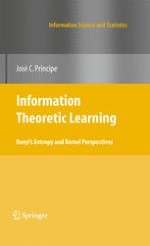2010 | OriginalPaper | Chapter
9. A Reproducing Kernel Hilbert Space Framework for ITL
Authors : Jianwu Xu, Robert Jenssen, Antonio Paiva, Il Park
Published in: Information Theoretic Learning
Publisher: Springer New York
Activate our intelligent search to find suitable subject content or patents.
Select sections of text to find matching patents with Artificial Intelligence. powered by
Select sections of text to find additional relevant content using AI-assisted search. powered by
